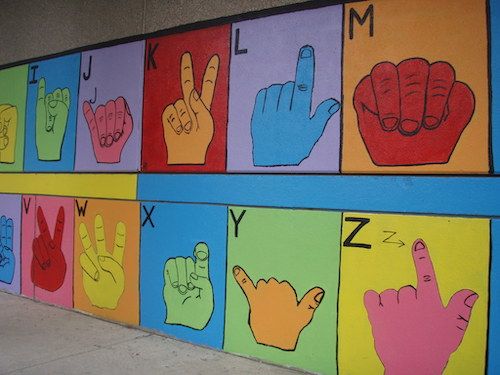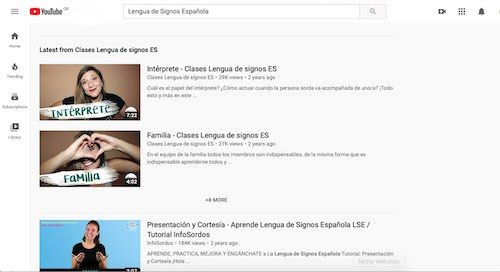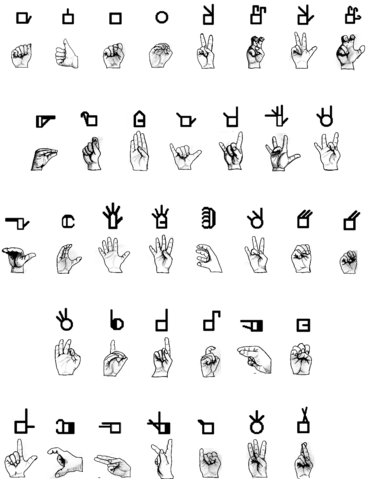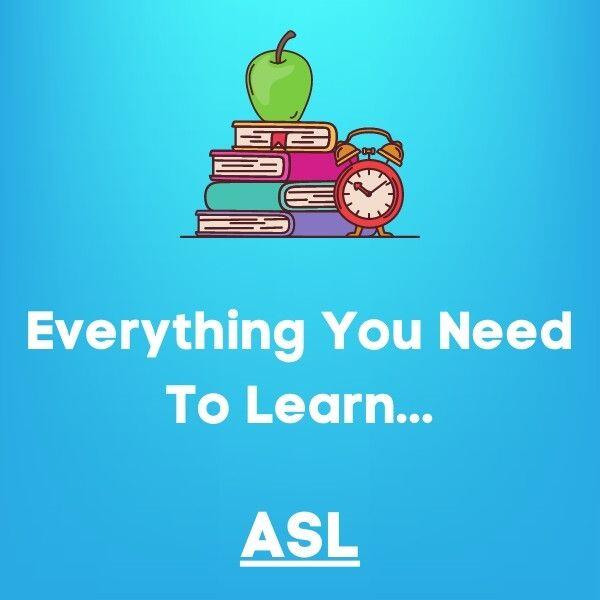Sign Language – Everything You Need To Know Before Learning
Sign language, the name given to the system of using visual gestures to convey messages, is the primary method of communication in the deaf and hearing impaired community.
If you intend to learn it, you should understand that it is a distinct language in and of itself, and thus has its own grammar and culture, just like spoken languages.
A few facts about sign language
The term “sign language” refers to a type, not one single, universal language. What you may not know is that there are roughly 300 unique, recognized sign languages (plus several hundred unrecognized ones) used around the world.
Most of them have nothing to do with each other. The reason being is, just like with spoken languages, they were developed independently over time in different countries.
A note about International Sign Language (IS): There is no real international sign language, not a natural one, at least. IS is a type of pidgin sign language developed to make communication between deaf people from different countries possible in international settings, like conferences and global events. Most deaf people, however, do not know or use it. You can learn it here on the ISLD site.
Some sign languages are more widely used than others, due to population size, access to education, etc.
The 15 most used sign languages in the world (in order of speakers):
| 1 | Chinese Sign Language (CSL) | 2 – 20 million |
| 2 | Indo-Pakistani Sign Language (IPSL) | 1.5 million+ |
| 3 | Ethiopian Sign Language (EthSL) | 1 million+ |
| 4 | American Sign Language (ASL) | 500,000 |
| 5 | Japanese Sign Language (JSL) | 350,000+ |
| 6 | Korean Sign Language (KSL) | 300,000 |
| 7 | Brazilian Sign Language (LSB) | 250,000 |
| 8 |
South African Sign Language (SASL) | 235,000 |
| 9 | German Sign Language (DGS) | 200,000 |
| 10 | British Sign Language (BSL) | 150,000+ |
| 11 | Russian Sign Language (РЖЯ) | 130,000+ |
| 12 | Mexican Sign Language (LSM) | 130,000 |
| 13 | Filipino Sign Language (FSL) | 100,000+ |
| 14 | Spanish Sign Language (LSE) | 100,000 |
| 15 | French Sign Language (LSF) | 100,000 |
A note about data: There are no hard, concrete facts about the real numbers of signers or the languages they use, so these are only estimates I’ve managed to compile through independent research gleaned from a number of different sources.
Sign language is a real, natural language
What you’ll see, as you start learning it, is that the language has its own unique grammar and syntax, and they have very little, if anything at all, to do with the spoken languages of their countries. This means that sign language is a foreign language, and is recognized as such in most countries across the world.
In verbal languages, different tenses and moods are expressed through things like word changes and alterations in voice and tone – such as an inflection at the end of a question, or a pitch fluctuation.
Because sign language cannot rely on these spoken signals, such things are conveyed with different body movements, facial expresses, sometimes simple cues that would likely go unnoticed by the hearing community, yet would be understood by other signers.
This article by Quartz, based on 2 studies, shows just how crucial these cues are in sign language comprehension.
Word order will differ from your native, spoken language. For example, English uses subject-verb-object to form sentences (“I want a ball”), whereas in British Sign Language, for instance, it’s usually object-subject-verb (“A ball I want”).
How many words exist in sign language?
As noted previously, different sign languages have different lexicons. A rough estimate would be anywhere from 5,000 to 10,000 signs in each language. Which means that they won’t have equivalent signs for many verbal language words.
In terms of remembering signs, this does make things a little easier. However, there will be instances where you’ll want to use words for which there are no signs. This is where fingerspelling comes into play.
What’s fingerspelling?

Fingerspelling is the method used to create letters with your hand(s) in order to spell out words. This is what is known as a manual alphabet, and there are approximately 40 of them in use across the world.
Many sign languages use the same manual fingerspelling system, but the speed with which some communities use them differs. Sometimes reading them can be difficult, if they’re hastily formed.
Some can be used with one hand, but others, like BSL, require both hands.
You will want to learn how to use fingerspelling, so that where you have forgotten a sign, or where no sign exists for a word, you will still be able to spell it out and express yourself.
How to learn sign language for beginners. Can it be learned online for free?
Due to the nature of this form of communication, conventional methods of learning will not be possible. The language is heavily dependent on visual memory, so those with bad memories might struggle.
The best and probably easiest way to start learning sign language is by watching videos, either through apps or websites. There are a plethora of sites with hundreds upon hundreds of free instruction videos for common signs. But YouTube would likely be one of the best places to start. A simple search for your chosen sign language should yield tons of results.
If you’re having trouble finding ones from non-English speaking countries, you might need to search in the country’s regular verbal language.

Be warned, though, that the written translations will probably also be in the spoken language, so you’ll need to understand that language too.
In some languages, like ASL and BSL, there are a lot more resources available, both free and cheap.
For ASL:
The ASL App, Galaudet (the leading deaf university), and Sign Language 101 are just some of the awesome free resources available for learning American Sign Language.
For BSL:
Sign BSL, British Sign Language.com, and BSL Sign Bank are a great place to start.
You’ll find video dictionaries on most of these apps/sites, which you’ll regularly refer back to while you study.
Other media
Where possible, you should try to watch as much strictly sign language or sign language inclusive content as possible to boost your skills. Some languages have shows and movies entirely in sign, and a lot of it is available for free online.
BSL Zone, by The British Sign Language Broadcasting Trust (BSLBT), is an awesome free website/app packed with diverse programming across different genres, all exclusively in BSL. You can watch comedies, short films, interviews, you name it.
It’s available on iOS, Android, and even the Kindle Fire.
SWITCHED AT BIRTH
There was a really good ABC family show that ran for 5 seasons, from 2011 – 2017, where about 40% of the dialogue was in ASL, and deaf actors and characters featured heavily. You got to see what the deaf community was like through their perspective, and really got a sense of some of the struggles they face.
I was hooked on it! I would highly recommend it as an introduction to ASL. Not only will you pick up loads of signs, the story of two girls who were accidentally switched at birth is enthralling.
If you’re in the US, you can watch it on Freeform. If outside, all seasons are available to buy on Amazon.
Finding people to communicate with
Finding signers, particularly for languages that aren’t used in your country, can be challenging. If you’ve chosen a sign language that’s used where you live, there will be local and national deaf groups and associations that you can join.
Even though you might be hearing, most people in the deaf community will appreciate your willingness to learn their language, so they’ll help you out where they can with language exchanges.
TANDEM
If you’re not yet ready to meet people in person, then may I introduce you to Tandem!
Tandem is a language exchange app where you can find natives to converse with from all over the globe, via video chat. The app has users of over 300 languages, and new ones are added regularly.
There are currently 20 sign languages available on Tandem. They are:
- American Sign Language
- Australian Sign Language
- Austrian Sign Language
- Brazilian Sign Language
- British Sign Language
- Chinese Sign Language
- Dutch Sign Language
- French Sign Language
- German Sign Language
- Indo-Pakistani Sign Language
- International Sign Language
- Italian Sign Language
- Japanese Sign Language
- Korean Sign Language
- Malaysian Sign Language
- Mexican Sign Language
- Polish Sign Language
- Russian Sign Language
- Spanish Sign Language
- Turkish Sign Language
Obviously, the number of users available varies from language to language, but you shouldn’t have trouble finding natives to sign with.
Choosing which sign language to learn
Before you start, you’ll need to figure out which one you want to learn. It would make sense to learn the one most common in your country, as it will be easier to find speakers and resources, not to mention that translations will be in your native language.
For instance, if you wanted to learn Korean Sign Language, you would likely have to know written Korean, because explanations would be in that language. Native English speakers would be better off sticking with ASL, BSL or Auslan (Australian Sign Language).
Frequently asked questions
How long does it take to learn sign language?
It will take you approximately 2 years of dedicated study to become conversationally fluent in sign language. You can learn the basics relatively quickly, in under 100 hours, and with that you’ll be able to communicate in simple terms. But more detailed conversations would require much more time.
Can you learn sign language on Duolingo?
Currently Duolingo does not offer any sign language courses, but the team are always adding new courses. If there’s enough demand, and enough native volunteers to create the course, then it will be added. So watch this space.
Can you learn sign language on your own?
You can learn any language by yourself, and sign language is no different. There are plenty of online resources that you can use from the comfort of your home.
However, there’s only so far solo study will get you. At some point your learning will stagnate, and in order to progress further, you’ll need to seek out natives with whom to converse.
Can you learn sign language with one hand?
It is possible to sign with just one hand, and is done so by those with only one hand, and those whose other hand might be occupied – as in carrying something. Regular signing is modified in these circumstances, and people are usually understood by fluent signers.
However, two-handed signing is the universal standard in pretty much all sign languages. Most signing requires the use of both hands. As such, you should learn to sign this way, where possible.
Is sign language hard/easy to learn?
Generally speaking, sign language isn’t any harder or easier to learn than any other language. There are instances where some might find it easier than others. For example, someone with dyslexia, who has trouble reading and writing, might have a much easier time of learning a language that doesn’t rely on the written word.
Conversely, those with visual impairments or a weak visual memory might struggle with it. As someone who learns best with words and reading, and doesn’t have the best memory, sign language has always been challenging for me.
But, as with any language, hard work yields results. If you dedicate enough time and effort to studying, you shouldn’t have any major problems learning sign language.
Why learn sign language? Is it a good skill to have?
Social benefits: There are over 70 million people globally who use a form of sign language as their native language. Wherever you live in the world, there are bound to be tens/hundreds of thousands or even millions of users. Being able to communicate with them opens up your world and gives you unique insights into a new community and culture.
Plus, the more hearing people who learn sign language, the more inclusive to deaf people the world becomes. If you have deaf family members, you should attempt to learn their language as a sign of love and respect.
Physical benefits: Using sign language is a unique way of expressing your thoughts and thinking outside the box, which builds your cognitive skills.
Spy benefits! : Imagine being able to have conversations with other signers that people around you could never eavesdrop on? Today, anyone can record and quickly auto-translate verbal languages with powerful, free apps. Sign language is one of the only languages where that is currently not possible.
Can sign language be written?

Though there is a form of written sign language that exists, called SignWriting, developed in 1974 (you can read about it here on Wikipedia), it is almost never used, and deemed unnecessary by the deaf community. Most deaf speakers learn to read and write the native spoken language of their country, and use that instead.
How do you think in sign language?
When practicing a new verbal language, you have to do a lot of thinking in it in order to become fluent. This is the same for sign language. You will have to think in signs, and visualize them to compose your thoughts. This is how the deaf community thinks.
This might be the hardest part of learning a sign language for a hearing person, as your first reaction will be to think in words, in your own voice. Turning that off will be difficult.
You should spend loads of time watching sign language in action; condition your mind to picture signs, and block out your voice.
You know how when something loud is playing people often say, “I can’t hear myself think?” Well, a neat trick might be to play unintelligible music or speech so that you can’t hear your voice, which would force you to think visually.
Can sign language help autism?
Studies show that, contrary to what some claim, teaching an autistic child sign language and a verbal language simultaneously actually helps the child to speak the verbal language. In this article by Springbrook Autism Behavioral Health, it shows the benefits to teaching sign language to people with autism.
Can you teach sign language to babies?
Teaching sign language to babies, both hearing and deaf, is a great idea, as it gives them a way to transmit their thoughts and feelings long before they’re able to speak verbally.
Check out the My Baby Can Talk series on Amazon Prime, where it teaches babies to sign very early, and thus communicate with their parents.
In Conclusion
Do not be fooled by the fact that sign language is non-verbal; it is just as powerful as any verbal language, and will be just as much, if not more, fun to learn. You’ll challenge yourself in a way you never have before, and pick up a skill that will make you see the world in a different light.
The deaf community is mostly welcoming of those interested in learning their language, and you can make lots of new friends.
Now, sign language won’t be for everyone. For some people it simply doesn’t stick. But you won’t know until you try. So check out an introductory YouTube video or sign language app to see if the language is for you.


